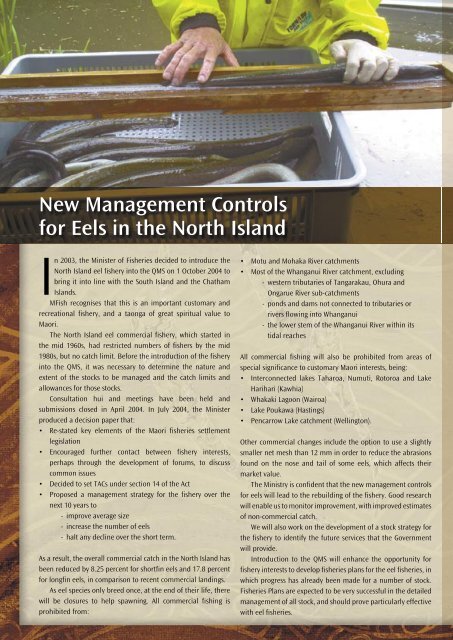Create successful ePaper yourself
Turn your PDF publications into a flip-book with our unique Google optimized e-Paper software.
New Management Controls<br />
for Eels in the North Island<br />
In 2003, the Minister <strong>of</strong> <strong>Fisheries</strong> decided to introduce the<br />
North Island eel fishery into the QMS on 1 October 2004 to<br />
bring it into line with the South Island and the Chatham<br />
Islands.<br />
MFish recognises that this is an important customary and<br />
recreational fishery, and a taonga <strong>of</strong> great spiritual value to<br />
Maori.<br />
The North Island eel commercial fishery, which started in<br />
the mid 1960s, had restricted numbers <strong>of</strong> fishers by the mid<br />
1980s, but no catch limit. Before the introduction <strong>of</strong> the fishery<br />
into the QMS, it was necessary to determine the nature and<br />
extent <strong>of</strong> the stocks to be managed and the catch limits and<br />
allowances for those stocks.<br />
Consultation hui and meetings have been held and<br />
submissions closed in April 2004. In July 2004, the Minister<br />
produced a decision paper that:<br />
• Re-stated key elements <strong>of</strong> the Maori fisheries settlement<br />
legislation<br />
• Encouraged further contact between fishery interests,<br />
perhaps through the development <strong>of</strong> forums, to discuss<br />
common issues<br />
• Decided to set TACs under section 14 <strong>of</strong> the Act<br />
• Proposed a management strategy for the fishery over the<br />
next 10 years to<br />
- improve average size<br />
- increase the number <strong>of</strong> eels<br />
- halt any decline over the short term.<br />
As a result, the overall commercial catch in the North Island has<br />
been reduced by 8.25 percent for shortfin eels and 17.8 percent<br />
for longfin eels, in comparison to recent commercial landings.<br />
As eel species only breed once, at the end <strong>of</strong> their life, there<br />
will be closures to help spawning. All commercial fishing is<br />
prohibited from:<br />
• Motu and Mohaka River catchments<br />
• Most <strong>of</strong> the Whanganui River catchment, excluding<br />
- western tributaries <strong>of</strong> Tangarakau, Ohura and<br />
Ongarue River sub-catchments<br />
- ponds and dams not connected to tributaries or<br />
rivers flowing into Whanganui<br />
- the lower stem <strong>of</strong> the Whanganui River within its<br />
tidal reaches<br />
All commercial fishing will also be prohibited from areas <strong>of</strong><br />
special significance to customary Maori interests, being:<br />
• Interconnected lakes Taharoa, Numuti, Rotoroa and Lake<br />
Harihari (Kawhia)<br />
• Whakaki Lagoon (Wairoa)<br />
• Lake Poukawa (Hastings)<br />
• Pencarrow Lake catchment (Wellington).<br />
Other commercial changes include the option to use a slightly<br />
smaller net mesh than 12 mm in order to reduce the abrasions<br />
found on the nose and tail <strong>of</strong> some eels, which affects their<br />
market value.<br />
The <strong>Ministry</strong> is confident that the new management controls<br />
for eels will lead to the rebuilding <strong>of</strong> the fishery. Good research<br />
will enable us to monitor improvement, with improved estimates<br />
<strong>of</strong> non-commercial catch.<br />
We will also work on the development <strong>of</strong> a stock strategy for<br />
the fishery to identify the future services that the Government<br />
will provide.<br />
Introduction to the QMS will enhance the opportunity for<br />
fishery interests to develop fisheries plans for the eel fisheries, in<br />
which progress has already been made for a number <strong>of</strong> stock.<br />
<strong>Fisheries</strong> Plans are expected to be very successful in the detailed<br />
management <strong>of</strong> all stock, and should prove particularly effective<br />
with eel fisheries.

















